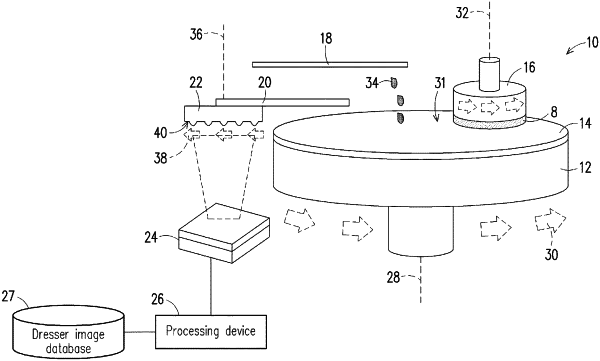| CPC B24B 49/18 (2013.01) [B24B 37/005 (2013.01); B24B 37/20 (2013.01); B24B 49/12 (2013.01); B24B 53/017 (2013.01); G01N 21/95607 (2013.01); G06T 7/001 (2013.01); H01L 21/3212 (2013.01); H01L 21/67253 (2013.01); G01N 2021/95615 (2013.01); G06T 2207/30164 (2013.01)] | 16 Claims |

|
1. A chemical mechanical planarization (CMP) system, comprising:
a turn table;
a polishing pad on the turn table;
a carrier overlying the turn table, the carrier configured to hold a wafer and move the wafer to be in contact with the polishing pad;
a slurry applicator overlying the turn table, the slurry applicator, in operation, dispenses a slurry on to the polishing pad;
a dresser arm configured to move to a first position and a second position;
a dresser coupled to the dresser arm, the dresser including an abrasive surface, the abrasive surface of the dresser contacts and reconditions the polishing pad in response to the dresser arm being moved to the first position, the abrasive surface of the dresser positioned away from the polishing pad in response to the dresser arm being moved to the second position;
an imager configured to capture a current dresser image of the abrasive surface of the dresser in response to the dresser arm being moved to the second position; and
a processor configured to:
instruct the dresser arm to move to the first position and the second position,
obtain a reference dresser image,
determine whether or not the dresser includes a defect based on differences between the current dresser image and the reference dresser image,
classify the current dresser image with a defective classification in response to the dresser being determined to include the defect, and
classify the current dresser image with a non-defective classification in response to the dresser being determined to not include the defect.
the reference dresser image being a previous dresser image having the defective classification or the non-defective classification.
in a case where the reference dresser image has the defective classification, the defective classification indicates a defect type included in the reference dresser image.
|